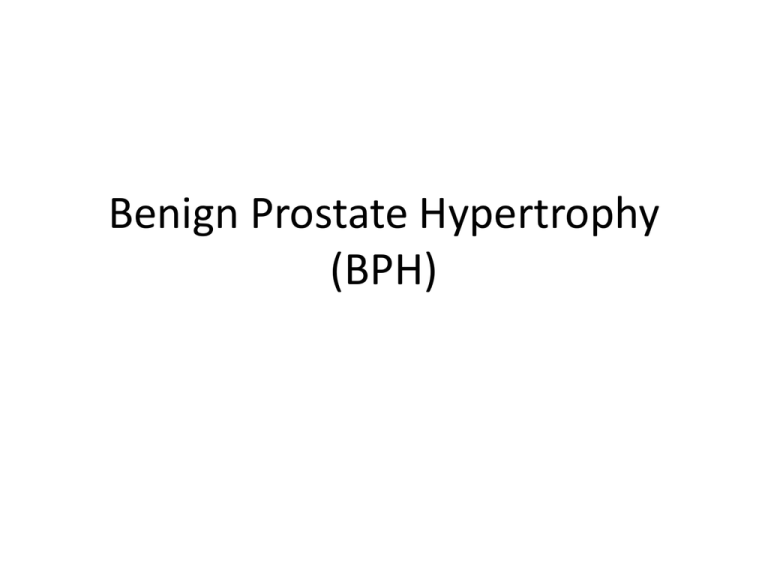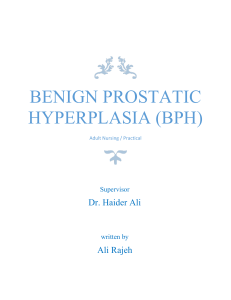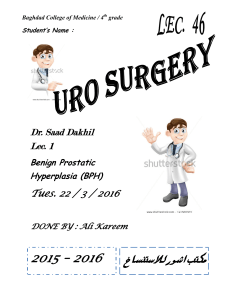Benign Prostate Hypertrophy (BPH)
advertisement

Benign Prostate Hypertrophy (BPH) Introduction • Benign prostatic hyperplasia refers to nonmalignant growth of prostate. – age-related phenomenon in nearly all men, starting at approx 40 years of age. • Histologically – – – – 10% of men in their 30s 20% in 40s 50-60% in 60s 80-90% in their 70s and 80s. • Prostate size increases from – 25g to 30g for men in 40s – 30g to 40g in 50s – 35g to 45g in 60s. Introduction • However, many men with histological BPH may never develop symptoms, which is when treatment is sought. • Etiology – poorly understood despite decades of intense research – hyperplasia thought to be stimulated by dihydrotestosterone (DHT) • Additional risk factors: positive family history Symptoms • Lower urinary tract symptoms (non-specific, can also include those with prostatitis, prostate cancer, bladder outlet obstruction like urethral stricture, stones, etc.) • Hesitancy, frequency, urgency, straining, weak flow, prolonged voiding, partial or complete urinary retention, small voided volumes, nocturia, painful urination. • If peak urinary flow rate <10 mL/s, then subvesical obstruction seen in 90% patients • Risk factors: changes to bladder anatomy and function, UTI, formation of bladder stones, renal failure Diagnosis • Careful history and physical examination including DRE • DRE notoriously unreliable in assessing size, in fact, shown to underestimate size of prostate • Still important because some men found to have prostate cancer based on DRE • UA, serum Cr. PSA depending on patient’s life expectancy and circumstances. – PSA is an individualized decision to be made with patient and physician Diagnosis • Further evaluate with AUA Symptom Score, or International Prostate Symptom Score (IPSS)—7 questions each on severity scale of 0-5: frequency, nocturia, weak urinary stream, hesitancy, intermittence, incomplete emptying, and urgency. • If score <8, mildly symptomatic and recommend yearly reevaluation • If 8-35, may consider additional tests if history confounded by neurological diseases, prior failed BPH therapy, and those considering surgery. • Optional tests: – Urinary flow rate <10 mL/s highly suggestive of outlet obstruction – Postvoid residual urine measurement with transabdominal ultrasound or in-and-out catheterization. Management • If no obstruction and limited discomfort, do not need to treat!! Non-pharmacological Management • • • • • • • Non-pharmacological Management · Mild symptoms or limited discomfort? o Watchful waiting and annual evaluation o Lifestyle Modifications Avoid fluids prior to bedtime or going out Reduce caffeine and alcohol Scheduled urination at least once every 3 hours. • Double voiding: after urinating, wait and try to urinate again. Pharmacological Treatment • Alpha-1-adrenergic antagonists – Relax smooth muscle in the bladder neck, prostate capsule, and prostatic urethra – Immediate relief! – Examples • Terazosin, Doxazosin – Initiate at bedtime (hypotension) • Tamsulosin, Alfuzosin – Lower potential to cause hypotension, syncope – Minor differences in the adverse events profiles, equal clinical effectiveness – Major Side Effects • HYPOTENSION! • Ejaculatory Dysfunction (particularly Tamsulosin) • Interaction with phosphodiesterase-5 inhibitors – Potentiated effects of hypotension – Separate doses by at least 4 hours Pharmacological Treatment • 5-alpha-reductase inhibitors – Reduces the size of the prostate gland – Prevents conversion testosteronedihydrotestosterone (DHT) – ~ 6 to 12 months before prostate size is sufficiently reduced to improve symptoms!! – Indefinite treatment, as discontinuation may lead to symptom relapse. – Examples • Finasteride (initiated and maintained at 5 mg once daily) • Dutasteride – Side Effects • Sexual dysfunction • Decrease PSA – Take into account during interpretation Pharmacological Treatment • Anticholinergics – monotherapy for patients with predominately irritated symptoms related to overactive bladder – Frequency, urgency, incontinence – Examples • Oxybutynin, Tolterodine – Side Effects • Extensive! • Dry mouth, blurred vision, tachycardia, constipation etc Pharmacological Treatment • Combination therapy – Severe symptoms without maximal response to maximal monotherapy – Alpha 1 and anticholinergics – Alpha 1 and reductase inhibitors If still fails? • If all else fails: Surgery or Minimally Invasive Surgical Therapies – Many surgical/interventional options – MIST • Transurethral needle ablation (TUNA), transurethral microwave therapy (TUMT), Transurethral Electroevaporation of The Prostate TUVP – Surgery • Open Prostatectomy – Endoscope • Transurethral Incision of the Prostatce (TURP) Management • When to get Urology involved? – Bladder Obstruction syndrome – Men <45 years old – Presence of hematuria in the absence of infection – Abnormality on prostate exam (nodule, induration, or asymmetry) – Men with incontinence – Severe symptoms References • Roehrborn CG. Benign prostatic hyperplasia: an overview. Rev Urol. 2005;7 Suppl 9:S3-S14. • McVary KT, Roehrborn CG, Avins AL, et al. Update on AUA guideline on the management of benign prostatic hyperplasia. J Urol. 2011 May;185(5):1793-803. doi: 10.1016/j.juro.2011.01.074. Epub 2011 Mar 21.










